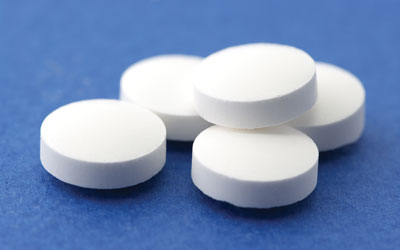Dynamic vapour sorption of freeze-dried pharmaceuticals
Posted: 22 October 2015 |
Freeze drying is gaining in importance as the number of biopharmaceuticals that are unstable in a solution increases. According to recent reports, a growth of 10% may be expected for freeze-dried products in the next 10 years. The technique offers the opportunity to gently dry temperature-sensitive drugs such as proteins or peptides. Since freeze drying is a rather expensive drying technology, formulation and process optimisation strongly focus on the design of a robust and fast cycle. Interestingly, partially crystalline systems offer advantages with regard to processability as well as product appearance.


Both formulation and process parameters affect the degree of crystallinity of excipients. For example, a high total or relative concentration of the bulking agent facilitates its crystallisation. Meanwhile, the freezing step is important, since freezing conditions strongly influence the crystallisation tendency of formulation compounds. A slow freezing rate and/or exposure to a temperature below the freezing point but well above the glass transition temperature of the maximally freeze-concentrated solute, Tg′, support crystallisation. In addition, during secondary drying, crystallisation may be finalised for several excipients, such as mannitol, and hydrates can be eliminated.
Accurate determination of the degree of crystallinity is imperative in drawing a reliable conclusion about process and formulation performance. In the field of freeze-dried products, differential scanning calorimetry (DSC) and X-ray powder diffraction (XRPD) are established methods for this purpose. However, dynamic vapour sorption (DVS) offers a new opportunity to measure the degree of crystallinity of the formulation components in a more representative way.
Crystallinity of excipients
In general, a material may exist in two distinct physicochemical states: crystalline or amorphous1, 9. In a crystalline material, the constituents are arranged in an orderly repeating pattern extending in all three spatial dimensions10. An amorphous material lacks this long range order and consists of molecules that are randomly oriented11. Heating a frozen crystalline material above the eutectic temperature, Teut, results in melt. Tg′ applies for the conversion of an amorphous material from a rigid glass into a rubber-like state. Both conversions relate to the critical formulation temperature of a system. Exceeding this temperature during primary drying may result in loss of cake structure and, thus, possible impairment of cake elegancy and/or loss of activity of the active pharmaceutical ingredient (API)12-14.
Stabilisers and bulking agents are frequently added to an API to improve final product characteristics15. The physicochemical state essentially influences ability to successfully perform their desired assignment. Chatterjee et al. demonstrated that a well-defined partially crystalline system of glycine and a carbohydrate ensured short process times and virtually complete recovery of the model protein lactate dehydrogenase16. Kim et al. showed that crystallisation of the bulking agent, such as mannitol, in the freezing phase supports formation of a robust cake structure and typically results in an elegant product appearance with fast reconstitution times5. In contrast, insufficient crystallisation during freezing bears the risk of vial breakage during the early phase of primary drying; furthermore, elevation of the residual moisture content in the product due to release of crystal water during long-term storage may compromise storage stability of some APIs3, 17. It is well known that the eutectic temperature of a material is much higher than Tg′18. Bulking agents that remain amorphous can significantly reduce the critical formulation temperature. Ma et al. reported that complete crystallisation of glycine significantly reduced process time of freeze drying of a monoclonal antibody19. Therefore, a high degree of crystallinity helps to avoid optical defects and may reduce process length. On the other hand, if an excipient is added to stabilise the active ingredient, it must remain amorphous and crystallisation must be avoided. A stabiliser has to remain in the amorphous phase in order to be able to form hydrogen bonds with the API1, 18. Accordingly, it has been reported that mannitol crystallisation may compromise protein recovery due to loss of the stabilising effect20, 21.
Historical and modern application of DSV
DVS is a technique used to investigate the effect of humidity on materials. The concept is based on gravimetric determination of the amount of vapour sorbed by a sample at a certain given humidity and temperature. Historically, sorption experiments were time and labour-intensive since a certain humidity was generated by using defined saturated salt solutions in desiccators and samples were repeatedly weighed until a constant mass was reached17. Moisture sorption behaviour of pharmaceuticals became a research area of interest in the early eighties. Ahlneck et al. reported that disorder in crystalline excipients in freeze-dried products may increase tendency towards water vapour absorption which is connected with an increase in chemical degradation of drugs22.
Likewise, Hageman et al. demonstrated that the choice of excipients influences vapour sorption behaviour and, thus, protein degradation in freeze-dried preparations23. When the first DVS was developed in 1991, the obstacles of continuous humidity generation were overcome. These modern instruments allow for an automated variation in vapour concentration and consist of a microbalance that constantly records change in sample mass. Hence, the determination of rapidity of water sorption is possible which provides further valuable information. In 1994, Marshall et al. collected information about water sorption behaviour of a series of pharmaceutical compounds for the first time with the automated instrument24.
Today, the technology is routinely used in the pharmaceutical industry for numerous applications25. During pharmaceutical development, possible drug substances and excipients may be analysed regarding stability, processing and application performance. Consequently, required storage conditions may be derived from sorption analysis at a given temperature and relative humidity. DVS analysis also plays a role in the analysis of packaging material with regard to permeability and effective protection of the pharmaceutical26, 27. As a side note, several instruments also permit the use of a wide range of organic solvents besides the use of water17.
A decade ago, a few first specific fields of use of DVS have been reported in the literature. For example, investigations included determination of the surface area calculation using the BET equation for either water or organic vapours28-30.
Although DVS is widely used for investigation of solids, detailed data in the field of freeze-dried pharmaceuticals is lacking. In fact, analysis of freeze-dried products has a high demand for rational method development and, thus requires a systematic approach. However, investigation of vapour-induced physicochemical changes of samples is highly promising17.
Established methods to investigate the degree of crystallinity
Frequently, X-ray powder diffraction (XRPD) is used in pharmaceutical development for the determination of the degree of crystallinity. The physicochemical state can be differentiated as crystalline phases lead to sharp peaks and amorphous phases to diffuse hills17. In order to estimate the amorphous and crystalline fraction of a substance the European Pharmacopeia advises to set the integrated area of the peaks arising from the crystalline fraction of the sample in relation to the total area of the graph. However, the diffraction pattern is characteristic for a defined individual substance, and total peak intensity strongly varies between different substances for the same amount of sample. In addition, XRPD analysis may be prone to errors since different polymorphs provide a different x-ray diffraction pattern. XRPD is a very valuable tool in order to qualitatively determine a substance but shows major weaknesses in quantitative phase analysis31. Use of an internal standard, for example lithium fluoride, may improve results. This method encompasses the spiking of each sample with a defined amount of an internal standard. Next, area of specific peaks is set in relation to the peak area of the internal standard (Figure 1; page 00). In this instance, it is necessary to determine a calibration line32, 33. However, the limit of detection of this method has been determined at 10%34.
Furthermore, analysis of differential scanning calorimetry (DSC) thermograms offers various options for quantification of the amorphous portion. DSC heating profiles of partially crystalline systems may show a glass transition endotherm, crystallisation exotherm and melting endotherm. Saleki-Gerhardt et al. propose correlating the amorphous content to the heat of crystallisation. Here complete crystallisation of the amorphous fraction is required33. Similarly Grisedale et al. compare the quantity of the amorphous fraction with the ratio of recrystallisation enthalpy to the melting enthalpy of the crystalline material. Both techniques fail if calibration is performed with different polymorphs. Additionally, they suggest that the quantification should be based on the assumption that heat capacity at the glass transition temperature is proportional to the amorphous content35. Finally, quantification of the amorphous phase is possible through the connection with the melting enthalpy of the crystalline fraction (Figure 2; page 00)36. It has been shown that DSC methods also fail to quantify amorphous content lower than 5% in predetermined mixtures34.
The concept: measurement of amorphous contents
Quantification of the amorphous content by DVS relies on the principle that amorphous material absorbs significantly more water vapour compared with their corresponding crystalline phases.34 Since water may act as a plasticiser, the glass transition temperature can be lowered to ambient temperature leading to crystallisation of the amorphous substance, which can be seen from a distinct release of water (Figure 3; page 00).
Prior to the analysis, calibration is generally required between the amount of water absorbed by the sample in equilibrium and the amorphous content37. In the literature, a more precise method is described that can be applied for a material that readily crystallises upon exposure to elevated relative humidities38. As a first step, sorption profiles of the material are analysed thoroughly in order to build up a sound understanding of recrystallisation behaviour. The information obtained is then utilised for the development of the measuring method. The main experiment consists of three main stages (Figure 4; page 00). Firstly, the amount of adsorbed water is measured by the partially crystalline sample at a relative humidity below the onset of recrystallisation. Secondly, recrystallisation is induced at elevated relative humidity, for example at 70% relative humidity. Finally, the amount of adsorbed water vapour by the fully crystalline sample is determined at the relative humidity already applied in the first step. The difference between the first and second gain in mass at the relative humidity below the onset of recrystallisation solely accounts for the amorphous content. For the determination of a calibration curve, about five known mixtures of the crystalline and amorphous material ranging from zero to one hundred percent of amorphous content are analysed with the above-described method. Subsequently, the actual sample analysis is performed in the same way and the amorphous content is calculated by the correlation.
The direct comparison
Table 1 (page 00) illustrates the results during a laboratory experiment evaluating the influence of solute concentration on the degree of mannitol crystallinity. For this purpose, freeze-dried cakes consisting of either 10mg/mL or 100mg/mL mannitol solution (28 vials, 20 mL, 5 mL fill volume) were freeze dried in a laboratory freeze dryer (Lyostar II, SP Scientific, Stone Ridge, NY, USA). The samples were frozen with a cooling rate of 1°C/min to -45°C. Primary drying was then performed at a shelf temperature of -37°C and a chamber pressure of 44 mTorr. Secondary drying was performed at a shelf temperature of 40°C and a chamber pressure of 44 mTorr.
The results obtained by XRPD (Philips X’pert MPD, PANalytical, Eindhoven, Netherlands), DSC (DSC822e, Mettler Toledo, Greifensee, Switzerland) and DVS (DVS Intrinsic, Surface Measurement Systems, London, UK) analysis are in good agreement and show that both concentrations result in approximately 100% crystallinity of mannitol (Table 1). When taking a closer look at feasibility of all techniques the most notable difference is that DVS is able to detect a lower amorphous content compared to XRPD or DSC. According to the literature, DVS is able to detect 0.5% amorphous content in a crystalline material34. All three techniques require calibration. Generally, calibration is performed in a certain range of crystallinity covering the expected result, before the operator analyses the sample and interpolates the unknown crystallinity.
It is rather difficult to utilise the same polymorph or mixture of polymorphs for the calibration for XRPD analysis that is present in the final freeze-dried product. It can even be observed that the composition of polymorphs in one batch of a freeze drying cycle differs. Furthermore, integration of the diffraction pattern is demanding since placement of the baseline for peak integration cannot be realised in a standard operating procedure and thus is rather subjective. A merit of XRPD is that the average sample analysis in the range 0-40° 2q takes only about 45 minutes, but requires sample masses of approximately 200mg. In contrast, DVS has the advantage that a small sample mass of about 5-50mg is sufficient for analysis. Finally, it can be seen from the obtained results that DVS provides values that are more precise with a smaller standard deviation compared to XRPD or DSC method.
Conclusions
DVS has already proved to be a valuable tool in pharmaceutical development. Considering determination of the amorphous content, it can be concluded that DVS experiments are one of the most sensitive methods. In the area of freeze-dried products, accurate determination of small amounts of amorphous material is essential in order to rationally optimise process and formulation parameters and ensure final product quality. Although further
research is needed, preliminary results suggest that DVS even succeeds in detecting subtle changes in amorphous content.
References
- JJ Schwegman, LM Hardwick, MJ Akers. Practical formulation and process development of freeze-dried products. Pharm Dev Technol. 2005; 10(2):151-73
- X Tang, MJ Pikal. Design of freeze-drying processes for pharmaceuticals: practical advice. Pharm Res. 2004; 21(2):191-200
- MJ Pikal. Freeze-Drying. Encycloppedia of Pharmaceutical Technology. 2007; p. 1807-33
- E. Y. Shalaev, W. Wang, L. A. Gatlin. Protein Formulation and Delivery, 2nd Edition. Rational Choice of Excipients for Use in Lyophilized Formulations. Taylor & Francis Group (2008)
- AI Kim, MJ Akers, SL Nail. The physical state of mannitol after freeze-drying: effects of mannitol concentration, freezing rate, and a noncrystallizing cosolute. J Pharm Sci. 1998; 87(8):931-5
- T Oguchi, K Terada, K Yamamoto, N Yoshinobu. Freeze-Drying of Drug – Additive Binary Systems. I. Effect of Freezing Condition on the Crystallinity. Chem Pharm Bull. 1989; 37(7):1881-5
- M. Pikal, S Shah, ML Roy, R. Putman. The secondary drying stage of freeze drying: drying kinetics as a funtkion of temperature and chamber pressure. Int J Pharm. 1990; 60:203-17
- K. Izutsu, S. Yoshioka, T. Terao. Effect of mannitol crystallinity on the stabilization of enzymes during freeze-drying. Chem Pharm Bull (Tokyo). 1994; 42(1):5-8
- AI Liapis, R. Bruttini. A theory for the primary and secondary drying stages of the freeze-drying of pharmaceutical crystalline and amorphous solutes: comparison between experimental data and theory. Sep Technol. 1994; 4(3):144-55
- JR Hook, HE Hall. Solid State Physics, 2nd Edition. Manchester Physics Series, John Wiley & Sons, ISBN 9780471928041 (2010)
- R Zallen. The Physics of Amorphous Solids. Wiley-VCH, ISBN 9780471299417 (2004)
- MJ Pikal, S Shah. The Collapse Temperature in Freeze Drying: Dependence on Measurement Methodology and Rate of Water Removal from the Glassy Phase. Int J Pharm. 1990; 62:165-86
- RJ Bellows, C. King. Freeze-drying of aqueous solutions: Maximum allowable operating temperature. Cryobiology. 1972; 9(6):559-61
- AP Mackenzie. Basic principles of freeze-drying for pharmaceuticals. Bull Parenter Drug Assoc. 1966; 20(4):101-30
- A Baheti, L Kumar, AK Bansalb. Excipients used in lyophilization of small molecules. J Excipients and Food Chem. 2010; 1:41-54
- K Chatterjee, EY Shalaev, R Suryanarayanan. Partially crystalline systems in lyophilization: II. Withstanding collapse at high primary drying temperatures and impact on protein activity recovery. J Pharm Sci. 2005; 94(4):809-20
- J Liu. Physical characterization of pharmaceutical formulations in frozen and freeze-dried solid states: techniques and applications in freeze-drying development. Pharm Dev Technol. 2006; 11(1):3-28
- W Wang. Lyophilization and development of solid protein pharmaceuticals. Int J Pharm. 2000; 203(1-2):1-60
- X Ma, DQ Wang, R Bouffard, A MacKenzie. Characterization of protein formulation for freeze-drying cycle development. Pharm Sci. 1998:543
- A Al-Hussein, H Gieseler. The effect of mannitol crystallization in mannitol-sucrose systems on LDH stability during freeze-drying. J Pharm Sci. 2012; 101(7):2534-44
- K Izutsu, S Yoshioka, T Terao. Decreased protein-stabilizing effects of cryoprotectants due to crystallization. Pharm Res. 1993; 10(8):1232-7
- C Ahlneck, G Zografi. The Molecular Basis of Moisture Effects on the Physical and Chemical Stability of Drugs in the Solid State. Int J Pharm. 1990; 62:87-95
- MJ Hageman. The Role of Moisture in Protein Stability. Drug Dev Ind Pharm. 1988; 14(14):2047-70
- R. Storey, I Ymén. Solid State Characterization of Pharmaceuticals. John Wiley & Sons Ltd (2011)
- SL Shamblin, BC Hancock, G Zografi. Water vapour sorption by peptides, proteins and their formulations. Eur J Pharm Biopharm. 1998; 45(3):239-47
- P York. Solid-state properties of powders in the formulation and processing of solid dosage forms. Int J Pharm. 1983; 14:1-28
- G Zografi, MJ Kontny. Sorption of Water by Solids. Physical Characterization of Pharmaceutical Solids. 1995:385-418
- PM Young, S Edge, JN Staniforth, DF Steele, R Price. Dynamic vapour sorption properties of sodium starch glycolate disintegrants. Pharm Dev Technol. 2005; 10(2):249-59
- JI Enrione, SE Hill, JR Mitchell. Sorption behaviour of mixtures of glycerol and starch. J Agric Food Chem. 2007; 55(8):2956-63
- J Zhang, G Zografi. The relationship between “BET” and “free volume”-derived parameters for water vapour absorption into amorphous solids. J Pharm Sci. 2000; 89(8):1063-72
- DB Black, EG Lovering. Estimation of the degree of crystallinity in digoxin by X-ray and infrared methods. J Pharm Pharmacol. 1977; 29(11):684-7
- X Lu, MJ Pikal. Freeze-drying of mannitol-trehalose-sodium chloride-based formulations: the impact of annealing on dry layer resistance to mass transfer and cake structure. Pharm Dev Technol. 2004; 9(1):85-95
- A Saleki-Gerhardt, C Ahlneck, G Zografi. Assessment of disorder in crystalline solids. Int J Pharm. 1994; 101:237-47
- S Sheokand, SR Modi, AK Bansal. Dynamic vapour sorption as a tool for characterization and quantification of amorphous content in predominantly crystalline materials. J Pharm Sci. 2014; 103(11):3364-76
- LC Grisedale, MJ Jamieson, PS Belton, SA Barker, DQ Craig. Characterization and quantification of amorphous material in milled and spray-dried salbutamol sulfate: a comparison of thermal, spectroscopic, and water vapour sorption approaches. J Pharm Sci. 2011; 100(8):3114-29
- MJ Richardson. Precision Differential Calorimetry and the Heat of Fusion of Polyethylene. J Polymer Sci. 1972; 38:251-9
- G Buckton, P Darcy. The use of gravimetric studies to assess the degree of crystallinity of predominantly crystalline powders. Int J Pharm. 1995; 123:265-71
- L Mackin, R Zanon, JM Park, K Foster, H Opalenik, M Demonte. Quantification of low levels (<10%) of amorphous content in micronised active batches using dynamic vapour sorption and isothermal microcalorimetry. Int J Pharm. 2002; 231(2):227-36
Biography
Claudia Kunz studied pharmacy at the University of Wuerzburg and received her license as a pharmacist for Germany in 2011. After first gaining professional experience in retail pharmacy, she joined the Freeze Drying Focus Group within the Division of Pharmaceutics at the University of Erlangen in 2013 as a graduate student. Her research interest is currently focused on Dynamic Vapour Sorption of freeze dried products as well as freeze drying from organic co-solvent systems. More information about Claudia Kunz can be found on the group’s official website: www.freeze-drying.eu.
Henning Gieseler studied pharmacy at the University of Wuerzburg and has been a licensed pharmacist in Germany since 2000. He received his PhD in pharmaceutics at the Department of Pharmaceutics, University of Erlangen, in 2004. After a post-doctoral research period at the School of Pharmacy, University of Connecticut (Prof. Michael J. Pikal, “UConn Freeze Drying”) until early 2006, he returned to his former department at the University of Erlangen where he founded the Freeze Drying Focus Group (FDFG) within the Division of Pharmaceutics. In 2010, Dr. Gieseler obtained his habilitation and venia legendi in Pharmaceutical Sciences from the University of Erlangen with the thesis “Quality by Design (QbD) in Freeze-Drying Using Advanced Process Analytical Technology”. In the same year, he also founded GILYOS in Wuerzburg, a contract service provider for pharmaceutical freeze drying.







